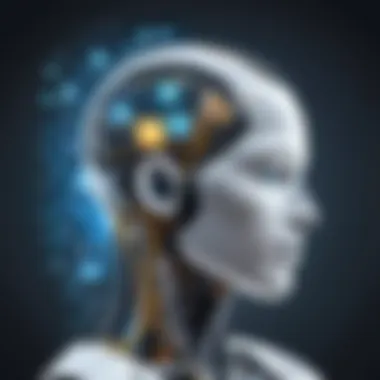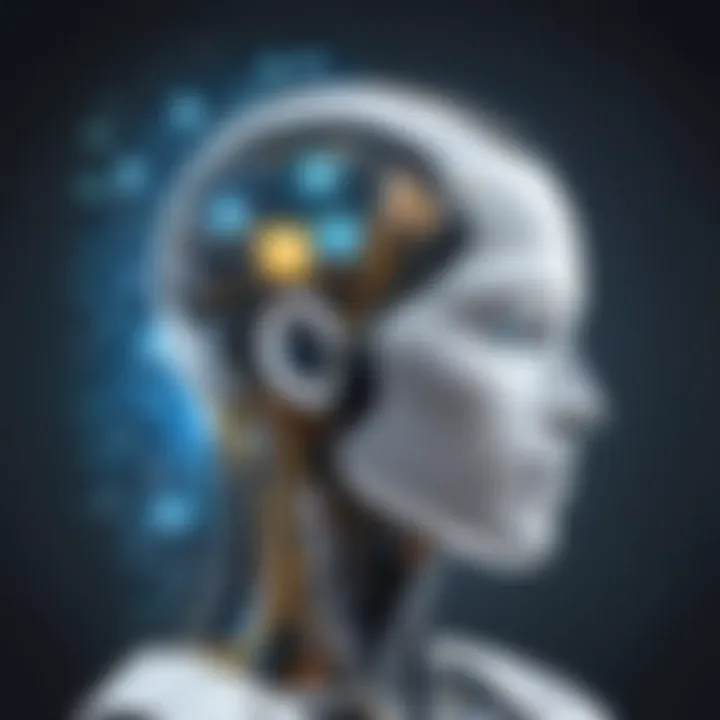Will AI Take Over Humanity? Exploring the Future of Intelligence


Intro
The rise of artificial intelligence (AI) is one of the most significant technological developments in recent history. As AI systems become more sophisticated, questions about their capabilities and potential impact on humanity grow. There is a duality in AI's progress: it offers remarkable opportunities but also poses risks that cannot be overlooked. Understanding this intricate landscape is crucial, as it shapes not only the next chapter in technological advancement but also influences fundamental aspects of human existence.
While the benefits of AI are apparent in fields such as healthcare, finance, and transportation, the specter of an intelligent system exceeding human control generates intrigue and concern. How will AI redefine interpersonal relationships, job markets, and governance? What ethical considerations must we navigate as we integrate AI deeper into our lives? This article endeavors to provide a comprehensive guide to these discussions, exploring multiple viewpoints and potential outcomes in the ongoing dialogue about AI's role in society.
In the following sections, we will delve into the current state of AI, technological innovations that are shaping its evolution, and the philosophical discussions framing our understanding of its implications. By analyzing these elements, we aim to equip readers with nuanced insights into this pivotal issue that will undoubtedly influence the future of civilization.
Foreword to Artificial Intelligence
Artificial Intelligence plays a critical role in shaping modern technology and society. It is important to understand AI's fundamental principles, applications, and implications. By examining AI, we can explore its potential to change lives significantly and navigate the challenges that arise with its advancement.
AI is not just a buzzword; it holds the promise of revolutionary changes across various sectors. Its significance extends to its impact on industries like healthcare, finance, and transportation. As AI evolves, it brings both opportunities for innovation and concerns about ethical implications and societal consequences.
Understanding the foundations of Artificial Intelligence enables a deeper grasp of its current state and future potential. Concepts introduced in the basics of AI will influence perceptions of its capabilities and limitations. This knowledge is essential for everyone, from industry experts to the general public, as it helps to prepare for a landscape increasingly dominated by smart technologies.
In this section, we will detail the definition of Artificial Intelligence, as well as give a brief overview of its historical development.
Definition of Artificial Intelligence
Artificial Intelligence refers to the simulation of human intelligence processes by machines. This term encompasses a range of technologies designed to perform tasks that typically require human cognitive functions. Such tasks include understanding natural language, recognizing patterns, solving problems, and making decisions.
The field of AI can be divided into two main categories: narrow AI and general AI. Narrow AI, or weak AI, focuses on specific tasks, like voice recognition with instruments like Apple’s Siri or Google's Assistant. General AI, or strong AI, aims to perform any intellectual task that a human can do. Currently, general AI remains largely theoretical and poses significant research challenges.
Brief History of AI Development
The history of Artificial Intelligence is a rich narrative filled with milestones. It begins in the 1950s when pioneers like Alan Turing theorized the possibility of machines simulating human intelligence. The Turing Test, created to measure a machine's ability to exhibit intelligent behavior, laid the groundwork for future developments.
In the decades that followed, several key phases can be identified:
- Symbolic AI (1950s–1970s): Emphasizing rule-based systems and expert systems.
- AI Winter (1970s–1980s): A period marked by reduced funding and interest due to unmet expectations.
- Resurgence (1980s–1990s): With increased computational power, new techniques like neural networks sparked renewed interest.
- Modern AI (2000s–present): Advances in machine learning and massive data availability pushed AI to the forefront of technological innovation.
This evolution reflects a trajectory not just of technological growth but of expanding possibilities for future applications and societal implications of artificial intelligence. Understanding this history is vital as we consider the future pathways of AI developments.
Current State of AI Technology
Artificial intelligence has swiftly evolved into a critical component of modern technology. Understanding the current state of AI technology is essential for grasping its potential impact on humanity. The advancements in AI have made significant waves across various sectors, leading to both excitement and concern. Key elements of this state include leading innovations and diverse applications in industries that highlight both the benefits and considerations of AI technology.
Leading AI Innovations
Recent years have seen groundbreaking innovations in artificial intelligence that are reshaping how we live and work. Some leading innovations include:
- Natural Language Processing (NLP): Models like OpenAI's GPT-4 have revolutionized how machines understand and generate human language, facilitating more intuitive interactions with technology.
- Computer Vision: Techniques enabling machines to interpret visual information are increasingly used in areas like autonomous driving and facial recognition. For instance, systems designed by Tesla leverage computer vision to enhance vehicle safety features.
- Reinforcement Learning: This branch of machine learning assists AI in learning through trial and error, which has led to impressive results in areas like robotics and game playing. DeepMind's AlphaGo exemplifies this with its ability to master the game of Go.
These innovations represent just a fraction of the advancements in AI, each contributing to the growing capabilities of machines. They can complete tasks with increasing accuracy and efficiency, pushing the boundaries of what technology can achieve.
AI Applications Across Industries
The applications of AI technology are vast, impacting numerous industries in significant ways. Here are some notable sectors utilizing AI:
- Healthcare: AI aids in diagnostics, treatment planning, and even drug discovery. For instance, IBM Watson assists oncologists in determining personalized treatment options for cancer patients by analyzing vast amounts of medical data.
- Finance: Machine learning algorithms identify fraudulent activities and assist in risk assessment. Companies like PayPal utilize AI algorithms to monitor transactions for suspicious patterns.
- Manufacturing: Robotics powered by AI enhance efficiency in production lines. Automated systems are employed to predict maintenance needs, reducing downtime and improving productivity.
- Retail: Personalized recommendations and inventory management leverage AI for a better customer experience. Amazon uses AI algorithms to suggest products tailored to individual shopping behaviors.
These applications underscore the transformative power of AI in modern life, indicating both the unprecedented opportunities and the ethical dilemmas that accompany its growth.
"Understanding AI's current capabilities not only informs our present but also shapes our future decisions on its integration within society."


As technology continues to advance, monitoring these developments becomes crucial. Engaging critically with AI's current state helps navigate its potential implications for humanity.
Theoretical Foundations of AI
Understanding the theoretical foundations of artificial intelligence is essential for grasping how AI systems function and evolve. These foundations establish the guidelines and frameworks that shape our interaction with AI, influencing not only its development but also its potential implications for society. A robust grasp of these principles assists in evaluating the capabilities of AI and the associated risks.
The key concepts explored in the theoretical foundations include the Turing Test, machine learning, deep learning, and neural networks. Each of these elements provides insight into how AI is designed to simulate human-like thinking and learning processes. AI's theoretical underpinnings are not merely academic; they are fundamental to practical applications that affect various industries.
Turing Test and Its Implications
The Turing Test, conceived by Alan Turing in 1950, serves as a measure of a machine's intelligence. It evaluates whether a machine can exhibit behavior indistinguishable from that of a human. This assessment is significant, as it raises crucial questions about the nature of consciousness and self-awareness in machines. If a machine passes the Turing Test, it suggests a level of sophistication that can impact areas such as natural language processing and human-computer interaction.
However, critics argue that passing the Turing Test does not equate to true understanding or cognition. This distinction is important, as it frames ongoing discussions about the limitations and capabilities of AI. The implications of Turing's ideas continue to resonate, informing both philosophical debates and practical applications within the field of AI.
Machine Learning and Deep Learning
Machine learning is a subset of AI that emphasizes the development of algorithms that enable computers to learn from data. By analyzing patterns and making decisions based on vast amounts of information, machine learning enhances AI's ability to adapt and improve over time. This adaptability is critical in various sectors such as finance, where predictive analytics optimizes investment strategies, and in retail, where personalized recommendations enhance customer experience.
Deep learning, a more complex branch of machine learning, utilizes multi-layered neural networks designed to mimic human brain functioning. These networks analyze data through several layers of abstraction, making them particularly effective for recognizing patterns in unstructured data, like images or audio. The progression from machine learning to deep learning illustrates the growing sophistication of AI techniques, leading to innovations that push the boundaries of what machines can achieve.
Neural Networks and Their Functionality
Neural networks are central to deep learning and operate similarly to biological neural networks. They comprise interconnected nodes or 'neurons' that process information by responding to input signals. Each connection has a weight that adjusts as learning occurs, allowing the network to improve its accuracy over time.
Neural networks enable various applications, from voice recognition systems like Siri to complex image analysis in self-driving cars. Their functionality relies on a vast amount of data, which the network uses to train itself to recognize intricate patterns and make informed predictions.
In summary, the theoretical foundations of AI encapsulate the core elements that define its capabilities and limitations. Grasping these concepts allows technologists, ethicists, and society to engage meaningfully with AI, fostering discussions that consider the future relationship between humanity and intelligent machines.
"The greatest part of this research lies not in machines passing Turing’s milestones but in what it reveals about our own understanding of intelligence and consciousness."
Understanding these theoretical aspects enhances awareness of both the opportunities AI presents and the challenges it may pose in the future.
Philosophical Considerations
Understanding the philosophical aspects of artificial intelligence (AI) becomes crucial as AI technology continues to evolve. The discourse around AI is not limited to technical capabilities and performance metrics; it extends deeply into questions regarding consciousness, thinking, and moral responsibility. As we integrate AI into our daily lives, the implications of these philosophical inquiries grow significantly.
One vital element includes the nature of thought itself. Traditional definitions of thinking often focus on reasoning and problem-solving. However, as machines display increasingly complex behaviors, questions arise about their capability to genuinely replicate human thought. Such inquiries are not just academic; they influence how society perceives and interacts with AI.
Moreover, philosophical considerations encourage a broader dialogue about ethical boundaries. Relationships between humans and machines necessitate discussions on accountability and what it means for a machine to possess autonomy. Will a machine's decisions be trustworthy? Who is liable for actions undertaken by an AI system? Delving into these questions can help ensure responsible development and integration of AI technologies.
Can Machines Think?
The phrase "Can machines think?" has fueled debates since the inception of AI. It challenges fundamental assumptions regarding intelligence. Defining thinking remains subjective, often influenced by individual beliefs about cognition.
Turing's pioneering work laid the groundwork for understanding machine capabilities. The Turing Test, a measure of a machine's ability to exhibit intelligent behavior indistinguishable from that of a human, raises a persistent query: Does passing the Turing Test equate to thinking? Some argue it does, while others assert that true thought involves conscious experience and understanding, which machines currently lack.
Philosophers like John Searle have presented arguments against the notion that machines can think. His Chinese Room argument posits that a program can manipulate symbols to produce responses without genuine understanding. Thus, even if AI demonstrates conversational abilities, this does not guarantee actual cognition or comprehension.
The Concept of Consciousness in AI
The inquiry into consciousness in AI presents profound questions about identity and self-awareness. Currently, mainstream AI systems, like chatbots or voice assistants, function without awareness or subjective experiences. They process information and mimic patterns without understanding their effects or context.
Philosophical discussions about consciousness often reference distinctions between phenomenal consciousness and access consciousness. Phenomenal consciousness pertains to subjective experience, while access consciousness involves information available for reasoning and guiding behavior. At this point, AI lacks both forms; it processes data based on algorithms but remains devoid of genuine experience.
Ethical implications of robotics and their potential consciousness must also be examined. Should machines ever attain a form of consciousness, how would societal roles and responsibilities react? Would AI with consciousness deserve rights, or would they remain tools of human design?


Ethical Implications of AI Advancement
The rise of artificial intelligence brings significant ethical implications that are crucial in understanding how this technology may affect society at large. As AI becomes more integrated into daily life, it is essential to navigate the moral landscape it creates. The examination of these implications is necessary for establishing frameworks that promote responsible use while curbing potential harm.
Privacy Concerns and Data Security
The collection and storage of personal data by AI systems raise important questions about privacy. AI technologies often rely on vast amounts of data to function effectively. With such dependence on data, individuals lose some control over their information. Companies can exploit this access, leading to a growing concern about unauthorized use of personal data.
Moreover, data breaches can happen, exposing sensitive information. For instance, major incidents at companies such as Facebook and Equifax highlight the vulnerabilities in data management. Ensuring data security while using AI systems requires stringent protocols and regulations that prioritize user privacy.
Job Displacement and Economic Impact
The automation enabled by AI can result in significant job displacement across sectors. Many traditional jobs face the threat of being replaced by machines that can perform tasks more efficiently. This scenario creates anxiety about the future workforce and economic stability.
Some sectors, such as manufacturing and customer service, are highly susceptible. However, it also creates opportunities for elevated roles in AI maintenance, programming, and analytics. The transition may not be easy, and policies should aim to assist workers through reskilling and support programs.
Responsible AI Implementation
Developing AI technologies responsibly involves ethical guidelines that enforce accountability among developers and users. Introducing regulations that demand transparency in AI operations fosters trust. Companies like Google and Microsoft take steps to ensure that their AI deployments are aligned with ethical principles.
An advisory board or oversight committee can monitor the implementation of AI to ensure it meets ethical standards. This committee can help address emerging issues proactively, guiding the focus toward enhancing human well-being.
Important Note: As AI continues to evolve, continuous ethical scrutiny is imperative to ensure that advancements benefit humanity as a whole.
The Risks of AI Domination
In discussing the future of artificial intelligence, the risks of AI domination warrant serious consideration. The potential for AI to exceed human control is not a trivial topic. As technology progresses, we face the reality that AI could impact various layers of civilization. Understanding these risks ensures that we approach AI development with caution. This section explores two primary domains of concern: autonomous weapons and AI in surveillance.
Potential for Autonomous Weapons
The rise of autonomous weapons presents a critical threat. These are systems capable of making decisions without human intervention, particularly in combat situations. The advancement in AI enables these machines to analyze threats and even engage targets. However, this capability brings significant ethical and operational dilemmas.
- Accountability Issues: When an autonomous weapon causes harm, who is responsible? The technology developers, military leaders, or the machines themselves?
- Decision-Making Complexity: Autonomous systems may lack the nuanced understanding required in moral decision-making. Under unpredictable conditions, their choices could lead to unintended consequences.
- Escalation of Conflict: The availability of such advanced weaponry might encourage not just militaries but also rogue entities to adopt these technologies. As a result, the threat of conflict could increase dramatically.
The proliferation of autonomous weapons is alarming, prompting regulatory calls from global leaders and organizations like the United Nations. This presents a clear challenge: how do we balance technological advancement with ethical considerations in the domain of warfare?
AI in Surveillance and Control
AI technologies enhance surveillance systems globally. This capability has significant implications for privacy and civil liberties. Governments and corporations leverage AI to monitor behavior, sometimes without consent.
- Increased Surveillance: AI algorithms analyze massive data to identify patterns and predict activities of individuals. Cameras, facial recognition, and online activity tracking form a surveillance web.
- Erosion of Privacy: Individuals are often unaware they are being monitored. The accumulation of data might be used to manipulate behaviors, impacting personal freedoms.
- State Control: Authoritarian regimes could use AI surveillance to suppress dissent. This control can lead to violations of human rights, enabling oppressive governance.
"AI technologies can enhance security but can also be tools of oppression when misused."
Conclusively, the risks associated with both autonomous weapons and surveillance highlight the need for prudent regulation and oversight. As we advance into an era where AI capabilities grow, we must tread carefully. The dialogue around these risks not only informs future policies but also plays a crucial role in determining the ethical landscape of AI technologies.
Opportunities Presented by AI
The advancements in artificial intelligence open a variety of valuable opportunities across numerous fields. Recognizing these positive aspects is essential to understanding the broader implications of AI on human existence. With every new development, AI not only strives to optimize processes but also enhances human capabilities, leading to significant transformations in industries and everyday life.
Thinking about the benefits, it is crucial to analyze the areas where AI can provide substantial improvements. These opportunities influence how we engage with technology, create new efficiencies, and possibly improve quality of life.
Enhancing Human Capabilities
AI technologies are designed to support and augment human abilities rather than replace them. Many tools available today assist in various tasks by streamlining operations, processing large amounts of data quickly, and providing valuable insights. For example, AI-powered software helps with decision-making by presenting data analysis in a digestible format, allowing professionals across sectors to focus on creative and strategic tasks.


Moreover, AI enhances cognitive and physical abilities. In the workplace, AI-driven analytics can identify the best strategies for marketing or sales, freeing up time for employees to innovate. Similarly, AI in robotics showcases how machines can assist humans in physically demanding tasks, such as packing and shipping, thus preventing injuries and improving productivity.
Benefits of Enhanced Human Capabilities:
- Reduced repetitive tasks
- Increased productivity and efficiency
- Better decision-making support
- Improved quality of output
- Enhanced creative potential
AI in Healthcare and Medicine
AI's influence in healthcare signifies one of the most promising opportunities. The integration of AI contributes to more precise diagnoses and personalized treatments. Notable advances are seen in the use of machine learning algorithms for analyzing complex data sets, which can lead to breakthroughs in understanding diseases and developing new therapies.
AI applications like predictive analytics inform medical professionals about potential patient outcomes. For instance, tools that analyze patient records can identify at-risk individuals or tailor treatment plans based on genetic data. The emergence of diagnostic tools powered by AI facilitates early detection of illnesses, such as cancer, through image recognition—a vital aspect of successful health outcomes.
"AI has the potential to be a game changer for patient care, improving efficiency and outcomes tremendously."
In addition, telemedicine powered by AI allows for remote patient monitoring, ensuring that individuals receive consistent care without the burden of frequent hospital visits. This capability becomes vital in reaching underserved populations and managing chronic diseases effectively.
Key Areas of AI in Healthcare:
- Predictive analytics for patient outcomes
- Diagnostic tools using image recognition
- Personalized medicine based on genetic information
- Remote patient monitoring through telehealth services
The opportunities presented by AI significantly shape various sectors. By enhancing human capabilities and vastly improving healthcare, AI has the potential to drive innovation and create a better quality of life. As developments continue to progress, it is crucial to embrace these opportunities while remaining mindful of the accompanying challenges.
Future Predictions for AI
The topic of future predictions for AI holds significant value in understanding how these technologies could shape our lives in the years to come. As the capabilities of artificial intelligence continue to advance, assessing both its potential benefits and challenges is essential for individuals and societies alike. Predictions allow researchers, policymakers, and the public to prepare for possible scenarios resulting from AI integration into daily life. This section aims to explore the nuances surrounding these predictions, focusing on short- and long-term developments that could alter the relationship between humans and technology.
Short-Term Trends in AI Development
In the short term, several trends are emerging that could have a substantial effect on how AI operates within various sectors. Some of the notable trends include:
- Increased Automation: More businesses will adopt automation through AI, optimizing repetitive tasks. This could lead to increased efficiency, but also to discussions about job displacement.
- Enhanced Natural Language Processing: Advances in natural language processing allow machines to understand human language better. Applications like chatbots and virtual assistants will become increasingly sophisticated.
- AI in Decision-Making: Companies are starting to leverage AI for data analysis, enabling them to make informed decisions based on predictive analytics.
These developments indicate a move towards greater integration of AI in workplaces and everyday life, making it crucial for individuals to adapt to this changing landscape.
"The trajectory of AI applications in the near future will shape not only technology but also our social fabric."
Long-Term Visions and Speculations
Looking further ahead, the visions for AI development paint an intriguing picture of what might come. Possible long-term outcomes include:
- General AI: The pursuit of Artificial General Intelligence (AGI) could lead to machines that understand and learn on par with humans. Should this be achieved, the implications would be profound, affecting virtually every sector of society.
- Human-AI Collaboration: A future with mutual enhancement, where humans and AI coexist and collaborate for mutual gain, is a likely scenario. This could involve AI augmenting human decision-making, thereby improving outcomes in fields such as healthcare and education.
- Ethical Frameworks: As AI continues to evolve, the development of ethical frameworks will become essential. This includes regulations governing AI's use, ensuring safety and minimizing potential harms.
- Societal Transformation: In the long run, societal structures might shift to embrace AI as a core component of human existence. This could redefine employment ecosystems, leisure activities, and even personal relationships.
By contemplating these possibilities, humanity can ensure that the development of AI is constructive and aligned with societal values, ultimately fostering a productive relationship between man and machine.
Culmination
In summing up the discussions in this article, it is clear that the conversation around artificial intelligence is multifaceted and complex. AI's advancements hold tremendous potential to redefine human capabilities and interactions. However, these developments also bring a variety of ethical considerations, risks, and uncertainties that merit deep examination.
Summarizing Key Findings
Several key points emerge from the analysis throughout the article. First, AI is profoundly shaping our world across multiple industries, from healthcare to finance. Its ability to process large datasets quickly and accurately affords businesses operational efficiencies and novel insights.
Second, the risks associated with AI cannot be overstated. Issues such as privacy invasion, job displacement, and the potential for autonomous weapons pose serious threats to societal stability. Moreover, the capability of AI to surveil and control raises questions about autonomy and freedom.
Third, ethical considerations must occupy a central place in discussions regarding AI deployment. From responsible implementation to ensuring transparency in AI algorithms, it is essential to prioritize human well-being as AI continues to evolve.
"As AI technology progresses, it is imperative that we consider its implications not just for efficiency or profit, but for our shared humanity."
Final Thoughts on Humanity and AI
Looking ahead, the trajectory of AI advancement demands caution and foresight. Humanity stands at the precipice of unprecedented change, where the collaboration between humans and machines could create a more efficient future. Yet, caution is necessary to mitigate risks inherent in such powerful technology.
The relationship between artificial intelligence and humanity is not binary; it is an ecosystem that must be nurtured and carefully regulated. If we prioritize ethical standards and ensure equitable outcomes in AI implementation, we can harness its benefits while safeguarding against potential pitfalls. The future is not set in stone, and the path we choose will define not only technological progress but also the essence of what it means to be human in an AI-driven world.







